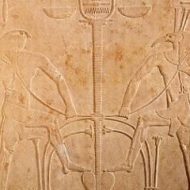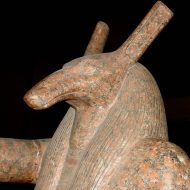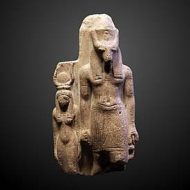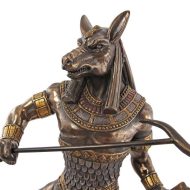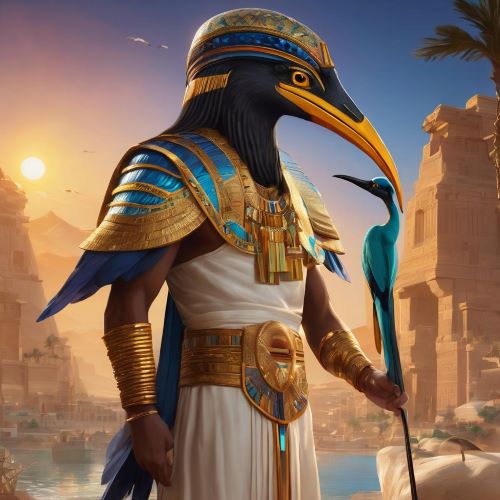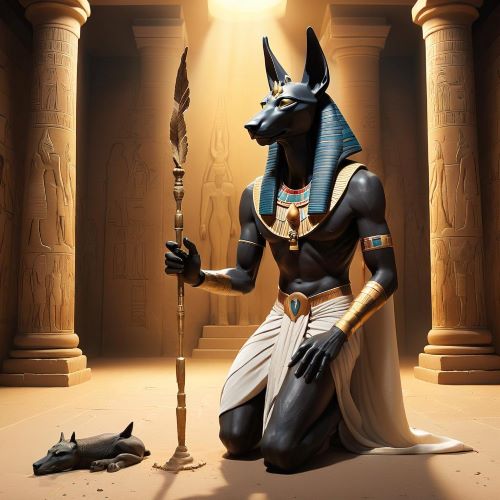Seth : The God of Chaos
Seth
Introduction
Seth, also known as Set or Sutekh, is a fascinating and multifaceted figure in Egyptian mythology. He embodies both destructive and protective forces, symbolizing chaos, storms, and the desert, while also playing crucial roles in maintaining cosmic balance and protecting the sun god Ra from the serpent Apophis. Seth is the patron of Upper Egypt’s 11th nome and was originally worshipped at Nubt, a predynastic center with a vast cemetery. Despite being regarded as an evil god later, Seth’s character was complex and vital in the mythological narratives of Ancient Egypt. His cult eventually died out during the 1st millennium BC, but his legacy as an “instigator of confusion” associated with people and foreign lands endures.
Physical Traits
Depictions of Seth vary throughout Egyptian history, but he is most commonly portrayed as a composite creature with a strong canine body. Artists often gave him a long, curved snout, slanting eyes, square-tipped ears, and a distinctive tail that could be forked or tufted. Some scholars believe his form reflects various desert animals, including the jackal, aardvark, or even the fennec fox, symbolizing his connection with chaos and disorder.
In Egyptian art and iconography, Seth is often represented with the head of a mysterious animal known as the “Seth animal,” which combines features of various creatures such as a donkey, aardvark, or jackal. This unique animal has a curved snout, long rectangular ears, and a forked tail, embodying the ambiguous and otherworldly nature of Seth. In some representations, Seth appears as a full anthropomorphic figure with a human body and the Seth animal’s head, highlighting his divine status. His images are typically bold and dynamic, reflecting his association with strength, chaos, and power.
Some believe that the “Seth animal” could also resemble a giraffe, as the flat-topped horns are similar to the giraffe’s ossicones. During the Late Period, Seth was depicted as a mythological creature, often as a red-haired figure with a long, curly tail and a dog-like body. Scholars suggest that this mythological creature might have been inspired by the Saluki breed or other animals like raccoons, crocodiles, tortoises, and griffins. The enigmatic “Seth animal” remains a distinctive and immediately recognizable symbol of Seth in Egyptian mythology.
Family
Seth, born to Geb (Earth) and Nut (Sky), is part of the divine Ennead of Heliopolis, with siblings Osiris, Isis, and Nephthys. His tumultuous relationship with Osiris is central to his mythology. Osiris, the first-born, became ruler of Egypt, teaching people laws and culture alongside his wife, Isis, who bestowed gifts of equality and compassion. This period was a paradise with abundant resources and equal rights. Seth, jealous of Osiris’s success, murdered and dismembered him, scattering his remains. This act led to Osiris’s resurrection by Isis and his role as the god of the afterlife. Seth’s wife and sister, Nephthys, bore him a son, Anubis, the god of mummification. Additionally, Seth had relationships with foreign goddesses Anat and Astarte, resulting in the birth of the crocodile deity Maga.
Other Names
The name “Seth” carries multiple interpretations. Common translations suggest meanings like “strength” or “dominator,” but it can also imply “chaos” or “destruction.” Egyptians used various other names for this god, reflecting his multifaceted nature. He was sometimes referred to as “Slayer of Enemies” or “Lord of Upper Egypt,” highlighting his connection with warfare and desert regions. Other variations of his name include Setekh, Setesh, and Sutekh, emphasizing his ancient origins and the evolution of his worship. The original pronunciation is thought to have been *sūtiẖ, with Late Egyptian spellings like stš and swtj showing linguistic changes over time. The Coptic form, ⲥⲏⲧ Sēt, is the basis for the English vocalization. Seth was also known as the “Lord of the Desert” and the “Storm-Bringer,” underscoring his dominion over barren lands and chaotic weather. During the Hyksos period, he was venerated under the name Sutekh, illustrating the adaptability and complexity of his identity within the Egyptian pantheon.
Powers and Abilities
Seth’s powers and abilities are vast, making him one of the most potent deities in Egyptian mythology. As the god of chaos and destruction, he wields immense strength and ferocity, controlling storms and the desert, elements that are both destructive and essential for natural balance. One of his notable roles is as the protector of Ra, the sun god. Every night, Seth defends Ra against Apophis, the serpent of chaos, ensuring the sun’s safe passage and the continuation of cosmic order. Despite his associations with disorder, this protective duty highlights Seth’s crucial role in maintaining harmony in the universe.
Seth is known for his exceptional physical prowess and combat skills, often depicted wielding a large scepter or spear, emphasizing his martial capabilities as a warrior deity. He is associated with foreign lands, storms, and warfare, and he commands these elements with authority. Additionally, Seth plays a protective role, particularly against Apep (Apophis), the serpent of chaos. He serves as a guardian on Ra’s solar barque, symbolizing the necessary balance between order and disorder.
During the Early Dynastic Period, Seth was regarded as a benevolent deity, known for granting love spells and saving Ra from Apophis. However, by the time of Ramesses II, Seth’s myth had evolved, and he was increasingly seen as a villain symbolizing foreign influence, famine, disorder, and waste. Despite this shift in perception, Seth’s multifaceted nature and formidable powers remain integral to Egyptian mythology.
Modern Day Influence
The legacy of Seth extends beyond ancient Egyptian religion, influencing modern culture in various ways. His complex character inspires works of fiction, including novels, films, and video games, where he is portrayed as a powerful and enigmatic figure. The themes of chaos, order, and the eternal struggle between good and evil associated with Seth resonate with contemporary audiences, making him a compelling subject in popular culture.
In modern spirituality and neo-pagan practices, Seth is sometimes venerated as a deity representing the necessary and transformative aspects of chaos. Practitioners may invoke Seth in rituals aimed at breaking down old structures to pave the way for new growth and understanding. His iconography and myths continue to be subjects of academic study and artistic interpretation, with scholars and artists exploring his role in ancient Egyptian religion and how his dual nature reflects the complex interplay of forces in the human psyche and the natural world.
Despite the decline of Egyptian worship, Seth remains present in popular culture. Comic book fans recognize him as a recurring villain in Marvel Comics, often depicted as an enemy of Black Panther. In heavy metal music, bands like Nile incorporate imagery and themes associated with Seth into their work. This enduring presence reflects the appeal of Seth’s multifaceted character. His story serves as a reminder of the delicate balance between order and chaos and the necessary role of disruption in the cycle of life and death. Seth’s importance in maintaining cosmic order, despite his destructive tendencies, highlights a nuanced worldview that acknowledges the necessity of both creation and destruction.
Related Images
Frequently Asked Questions
What is Seth the Egyptian god of?
Seth, the Egyptian god, wasn’t a simple villain. He ruled the wild deserts, bringing storms and chaos. However, he also wielded violence to protect, like a warrior guarding the sun god’s boat. This complex god embodied both the dangers and the balance needed in the world.
Is Seth and Anubis the same?
What animal is Seth the god?
Unlike many Egyptian deities with clear animal associations, Seth’s exact form remains a subject of debate among Egyptologists. While most depictions portray him with a powerful canine body, the specific animal is unclear. Theories range from the familiar jackal to more exotic possibilities like the aardvark or fennec fox.
Why was Seth jealous of Osiris?
The reasons for Seth’s jealousy of Osiris remain murky. One theory suggests a power struggle, with Seth coveting Osiris’ throne and influence. Another explores sibling rivalry, with Seth resenting perceived favoritism towards Osiris. A more philosophical view sees it as a clash of cosmic forces – Seth, god of chaos, disrupting the order established by Osiris.
Why did Seth sleep with Horus?
Contrary to some interpretations, the story of Seth and Horus likely doesn’t involve literal sexual contact. Scholars debate whether it was a symbolic act of dominance, with Seth aiming to humiliate Horus. Regardless, the encounter served a purpose in their power struggle. Seth might have used it to assert dominance or even transfer power (or a curse) to Horus, further complicating their fight for the throne.



